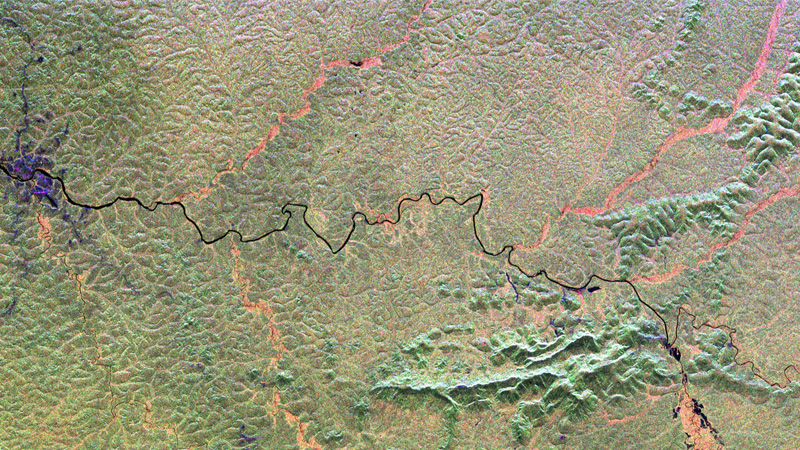The world’s rainforests are vital for our survival. They cover just 6% of the world’s land, yet host half of the planet’s species and store billions of tonnes of planet-warming gases, helping to mitigate climate change.But rainforests are dense and sprawling. Scientists have struggled to understand what lies beneath the treetops because even the most powerful satellites cannot penetrate their thick canopies - until now. The vivid colours in these first breathtaking images from the Biomass satellite reveal what lies below the treetops, from wetlands previously hidden beneath the foliage to concealed deforestation.Twenty years in the making, the European Space Agency’s Biomass is the first satellite of its kind to use a specific radar frequency to “see” through clouds as well as dense foliage. Scientists can now measure the amount of woody material in the trunks - where most carbon is stored - and better grasp the role these ecosystems play in fighting climate change. This is how the Bolivian rainforest appears from a conventional satellite. Here, the new satellite reveals stunning variety within the tropical forest landscape. Green hues indicate forested areas; blue–purple tones suggest grasslands; and the red hues seen around Bolivia’s rivers signify forested wetlands. Each stores different amounts of carbon. These images are only possible because of the unique radar technology aboard Biomass. The satellite was launched on 29 April from French Guiana and has spent the last two months beginning to collect data over the tropics. The data gathered by the satellite will be refined by teams of scientists who will head deep into remote areas of rainforest identified by Biomass to take measurements. The ultimate goal, over the coming years, is to produce a global 3D map of the world’s forests, enabling scientists to accurately estimate how much carbon they store. The Halmahera rainforest, located on the volcanic islands of Indonesia, is notoriously difficult for scientists to access due to its mountainous terrain. Yet the Biomass satellite can see right down to the forest floor, showing where the trees grow across the rugged landscape and where trees have been cleared for farming. As conventional satellites of this kind are unable to see beneath the treetops, patches of illegal deforestation can go unnoticed for months or even years. Biomass will help authorities to react more swiftly. The long wavelength of the P-band radar also allows it to penetrate deep into ice. Unlike other radar wavelengths, it is less affected by snowfall, which can distort measurements. One of the first images captured is a mesmerising view of the Nimrod Glacier in the Transantarctic Mountains of Antarctica. The large ice stream can be seen in extraordinary detail as it flows into the Ross Ice Shelf, surrounded by frozen tributaries. Purple areas show where the radar has penetrated further, because of differences in the structure of the ice. These insights provide more accurate data on glacier movement worldwide, which is essential for the billions of people who depend on glaciers for fresh water, and who face increased risk as melting accelerates due to climate change. Krystina Shveda, Daniel Wainwright and Tom Finn Matt Mitchell-Camp The satellite that will 'weigh' world's 1.5 trillion trees Tropical forests destroyed at fastest recorded rate last year Esa approves Biomass satellite to monitor Earth's forests
Pioneering satellite reveals rainforests' hidden worlds
TruthLens AI Suggested Headline:
"New Biomass Satellite Enhances Understanding of Rainforest Ecosystems and Glacial Movements"
TruthLens AI Summary
Rainforests, covering only 6% of the Earth's land surface, play a crucial role in supporting biodiversity and mitigating climate change by storing vast amounts of carbon. However, understanding the intricate ecosystems beneath their dense canopies has been a challenge for scientists, as traditional satellites have struggled to penetrate the thick foliage. The recent launch of the European Space Agency's Biomass satellite marks a significant advancement in this field. Utilizing a unique radar frequency, Biomass can effectively 'see' through clouds and dense vegetation, revealing previously hidden landscapes such as wetlands and areas of deforestation. This pioneering technology has already produced stunning images that highlight the diverse tropical forest ecosystems, showcasing different carbon storage capacities across various terrains, from grasslands to forested wetlands. The satellite, which began data collection in May 2023, aims to create a comprehensive 3D map of the world's forests, enhancing our understanding of their carbon storage capabilities and their role in combating climate change.
In addition to monitoring rainforests, the Biomass satellite is equipped to penetrate ice, providing valuable insights into glacial movements. One of its early images captured the Nimrod Glacier in Antarctica, revealing intricate details of the ice stream and its surroundings. This capability is particularly important as many communities globally rely on glaciers for freshwater, facing increasing risks from accelerated melting due to climate change. The long wavelength of the P-band radar used by Biomass is less susceptible to interference from snowfall, allowing for accurate measurements even in challenging conditions. As the data collected by Biomass is analyzed, it promises to enhance our response to illegal deforestation and improve overall forest management practices, paving the way for more effective conservation efforts in the face of growing environmental challenges.
TruthLens AI Analysis
You need to be a member to generate the AI analysis for this article.
Log In to Generate AnalysisNot a member yet? Register for free.
